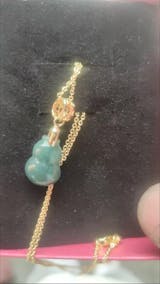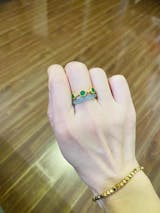A Beginner’s Guide to Wenwan Walnuts: History, Meaning, and How to Choose a Pair
Introduction
In traditional Chinese culture, Wenwan walnuts are more than just a hand exercise tool—they are artistic, practical, and collectible. Today, they’re also valued as natural fidget toys, offering a quiet, stress-relieving way to stay focused and calm in daily life.

What Are Wenwan Walnuts?
Wenwan walnuts, also known as hand-playing walnuts, are different from ordinary edible walnuts. They come from specially cultivated or naturally occurring walnut varieties known for their hard shells, elegant textures, and symmetrical shapes. Over time and with frequent handling, they develop a glossy surface, gradually darkening from light yellow to deep red, with a smooth, porcelain- or agate-like finish.
Besides their aesthetic value, Wenwan walnuts also provide health benefits. According to Traditional Chinese Medicine, rolling walnuts in the palms helps stimulate acupressure points, improve circulation, and support internal organ function. They are especially beneficial for people who sit for long hours or are middle-aged and elderly.
Historical Roots of Wenwan Walnuts
Wenwan walnuts date back to the Han Dynasty and became widespread during the Tang Dynasty. In the Ming and Qing dynasties, they reached peak popularity among emperors and scholars. There are even records of rulers neglecting affairs of state due to their obsession with these captivating nuts. In the Qing court, Wenwan walnuts were offered as tributes and symbolized status and taste.
Today, several royal Wenwan walnuts are preserved in museums. These pieces, some worth tens of thousands of dollars, showcase unique shapes and textures formed by years of dedicated handling. They are viewed as “living artifacts” with both cultural and collectible value.

Four Tips to Choose a Pair of Walnuts
If you're new to Wenwan walnuts, understanding how to evaluate them is essential. Here are four main factors to consider:
- Quality: From a quality perspective, ideal Wenwan walnuts should be heavy, have thick shells, and possess moderate density and hardness. They should also develop color quickly. With long-term handling, such walnuts produce a clear, stone-like sound when tapped together, develop a warm luster like red jade, and take on a color resembling amber—pleasing to both the eye and the hand.
- Form: Form" refers to the shape, texture, and pairing of Wenwan walnuts. The most iconic shapes are the four famous types listed in the classic manual Crafted Walnut Records: Lion’s Head, Tiger Head, Chicken Heart, and Scholar’s Cap.While there are both mainstream shapes and more unusual or irregular ones, it's especially important for beginners to choose a shape that feels comfortable and easy to handle.
- Color: "Color" refers to the natural changes in the walnut’s appearance over time. During the process of handling and polishing, the color gradually deepens and transforms. Due to differences in variety and origin, Wenwan walnuts can vary significantly in their natural skin tone. Freshly harvested, untreated walnuts—often called raw white walnuts—may appear white, pale yellow, or light brown. Regardless of the initial color, the most important thing is that the tone is naturally even and consistent.
- Size: "Size" refers to the overall dimensions of the walnut. Generally,the larger the walnut—with good shape and appearance—the more valuable it is. For everyday collecting or playing, a suitable size typically falls between 35 to 40 millimeters in width (measured across the edge). Walnuts with an edge width over 43 millimeters are considered rare and highly prized.

Recommended Varieties for Beginners
If you're just getting started, the following varieties are known for being beginner-friendly. They color quickly, are easy to handle, and offer stable quality—perfect for practice or entry-level collecting.
1.White Lion
White Lion walnuts are favored for their fast color transformation and satisfying polish. Their "cross-tip" design helps reduce the chance of tip breakage, making it easier to achieve a flawless finish. This variety is especially suitable for beginners due to its resilience and rewarding appearance.
2.Millstone Lion’s Head
Millstone Lion’s Head walnuts are known for their excellent surface quality and quick patina development. They feature a short, plump build with a wide belly, resembling a millstone. Typically sized between 35–43mm, they gain color easily—even without turning deep red, the change is obvious—earning high praise from players.
3.Apple Garden Lion’s Head
This variety combines the roundness of Millstone walnuts with the upright stance of the Four Towers type. It has a dignified appearance and is usually smaller (around 43mm, rarely 46mm). Its soft skin and shallow grain pattern make it easy to color and comfortable to use. Its compact size also reduces the risk of damage for new players.
4.Toad Head
Toad Head walnuts have a distinctive look, round and full with flowing lines that resemble a toad’s head. They have a wide belly, thick sides, and a flat base that sits well in the palm. With their dense, oily texture, they color quickly and develop a rich shine. They’re visually striking and beginner-friendly.
5.Four Towers
A true classic, the Four Towers type features a symmetrical shape, orderly grain, short build, large belly, and thick, flat base. With dense skin and a solid feel in hand, they respond quickly to handling and show visible color changes within months. Their balanced design makes them ideal for long-term play.
6.Panshan Tri-edge
Originating from the traditional "Panshan Prince Hat" shape, this variety is known for its firm shell and excellent polish. They develop color rapidly, often turning bright red over time with a porcelain-like luster. As a high-yield variety, they are more affordable and accessible—an ideal entry point for newcomers.

The Four Stages of Wenwan Walnut Polishing
Stage 1: Priming (Base Preparation)
This is the foundational stage where the raw walnuts are thoroughly cleaned and brushed to remove the white alkali layer on the surface. This “priming” process helps the skin begin to show its natural tone—usually a light yellow—and gives the walnuts a subtle early shine, setting the stage for further polishing and color development.
Stage 2: Glazing
With continuous handling and brushing, the walnuts will become glossier—a process known among experienced players as "gua ci", or surface glazing. This stage prepares the walnuts for deeper color development and more even patina in the next phases. Tip: many enthusiasts use a nano brush for effective and gentle cleaning.
Stage 3: Patina Formation
In this stage, the walnuts begin to develop a patina by absorbing the natural oils and sweat from your hands during play. It's important to follow the golden rule: 70% brushing, 30% handling. Some deeper crevices may not color evenly, so brushing is essential to distribute the patina smoothly. Over time, the walnuts shift from yellow to deep brown, then gradually turn red. If you want a rich, glossy red tone, frequent brushing is key—otherwise, the color may lean toward a dark soy-sauce hue.
Stage 4: Jade-like Finish
After a long period of care and conditioning, the walnuts may reach the most coveted stage: "Yu Hua", or jade-like transformation. At this point, the surface appears glossy, translucent, and smooth to the touch—just like jade. Under the light, they shine with a reddish glow and a refined texture. This is considered the ultimate achievement by Wenwan masters.

Final thoughts
Wenwan walnuts are more than just collectibles — they’re a living expression of culture, balance, and mindful living. If you’re drawn to the beauty of Natural Color Walnuts, you’re already on the path to a meaningful journey. The right pair not only feels good in the hand but also brings calm and focus into your daily life. Visit our shop and discover Wenwan walnuts that speak to your taste — and start a rewarding practice that connects tradition with personal well-being.
FAQs
1. Can I wash Wenwan walnuts with water or wipe them with a damp cloth?
No. Moisture can seep into the wood grain, causing mold, cracks, and damage to the patina.
2. How should I safely clean raw walnuts with flesh or skin residue?
Use a toothpick or stiff brush to dry-clean the surface. If needed, use a small amount of water quickly, then wipe dry and air-dry in the shade.
3. What should I do if the walnuts feel sticky after daily use?
Wipe them with a clean, dry cloth to remove sweat and oil buildup. This helps maintain a healthy and even patina.
4. How should I store Wenwan walnuts when not in use?
Keep them in a sealed bag. Use desiccants in humid regions and humidifying packs in dry areas to avoid moisture extremes.
5. How do I clean dust or dirt stuck in the walnut grooves?
Use a soft brush or toothbrush to gently sweep along the grain. For deeper spots, use a toothpick carefully.
6. Can I restore the color if the patina turns dull or dark?
To some extent. Light issues may be improved by regular dry brushing, but heavily damaged patina may require restoration, with limited results.
7. Can I dry walnuts in the sun or near a heater to speed up drying?
Absolutely not. Heat exposure can cause rapid shrinkage, cracks, or warping.
8. Should I apply oil or treatment products to the walnuts?
Not recommended. Natural hand-play is best. Applying oil can darken the surface unevenly and harm the patina.
Related articles:
What Makes Wenwan Walnuts So Valuable to Collect and Play?
Wenwan Walnut Polishing Guide: How to Get the Perfect Red Patina
Lion’s Head Wenwan Walnut: History, Cultural Significance, and Collector Appeal
Do You Have to Wear Gloves When Playing with Bodhi Bracelets?



























































